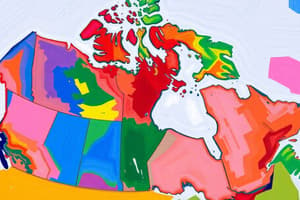Podcast
Questions and Answers
What are physical characteristics?
What are physical characteristics?
- The weather over a long period of time
- Modifications people have made to the land
- Describe the natural environment of a place (correct)
- Landforms and bodies of water
What are human characteristics?
What are human characteristics?
- Describe the natural environment of a place
- The animals that live in a location
- The climate of an area
- Modifications people have made to the land (correct)
What are physical features?
What are physical features?
Landforms and bodies of water
What do weather and climate refer to?
What do weather and climate refer to?
What is soil?
What is soil?
What are minerals?
What are minerals?
What is vegetation?
What is vegetation?
What is included in animal life?
What is included in animal life?
What are human-made features?
What are human-made features?
What is language?
What is language?
What is religion?
What is religion?
What is a political system?
What is a political system?
What are economic activities?
What are economic activities?
What is population distribution?
What is population distribution?
Flashcards are hidden until you start studying
Study Notes
Geographic Characteristics Study Notes
-
Physical Characteristics: Refers to the natural environment of a location, encompassing landforms, climates, and ecosystems.
-
Human Characteristics: Involves alterations made by humans to the landscape, such as urban development, agriculture, and infrastructure.
-
Physical Feature: Includes various landforms (mountains, valleys) and bodies of water (rivers, lakes) that define the landscape.
-
Weather and Climate:
- Weather: Describes short-term atmospheric conditions, including temperature and precipitation.
- Climate: Refers to long-term weather patterns and averages over time for a specific region.
-
Soil:
- Comprises the upper layer of Earth where plants can grow; contains sand, silt, and clay.
- Different types of soil exist globally, affecting agricultural practices and vegetation.
-
Minerals: Natural resources found in the Earth, such as coal and gold, which are extracted from rock and soil.
-
Vegetation: Plant life present in an area, categorized into types like forests, grasslands, tundra, and deserts, all influenced by climate conditions.
-
Animal Life: Encompasses all species of animals, both large and small, inhabiting the Earth’s diverse ecosystems.
-
Human-Made Features: Modifications to the environment created by humans, including infrastructure like buildings, bridges, and roads.
-
Language: A system of communication using words, symbols, or gestures understood within specific cultures, facilitating interaction and community cohesion.
-
Religion: Encompasses belief systems regarding deities and the practices and rituals associated with worship and moral guidance.
-
Political System: The framework through which power, authority, and governance are organized, reflecting societal values and historical contexts.
-
Economic Activities: Methods through which humans secure livelihoods, which can vary significantly across regions based on resources and economic systems.
-
Population Distribution: Highlights how populations are spread across areas; urban centers typically have higher densities compared to rural zones, often near water sources rather than arid locations.
Studying That Suits You
Use AI to generate personalized quizzes and flashcards to suit your learning preferences.




